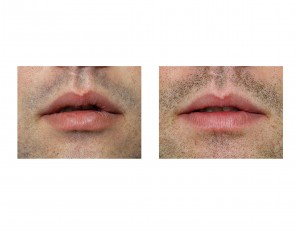Background:While considerable cosmetic effort goes into making lips larger, the need or desire for the opposite effect is much more limited. Reduction of lips that are perceived to be too big is largely limited to certain ethnic groups and some lip enhancement patients that wish to reverse their unnaturally large and distorted lips.
While lip reduction is usually for large lips or macrocheilia,, it can also be done for removing abnormal or damaged lip tissue. One of the more common pathologic conditions is that of dry lips. The lips are of two different types of coverings. The outer or visible vermilion of the lip is dry and is only wetted periodically by our tongues or application of lip balms or lipsticks. The non-visible lining of the lip is the wet vermilionor mucosa which is always moist due to its more intraoral location and its moisture-secreting glands.
For unknown reasons, some people will have areas of the dry vermilion which are too dry. This can cause chronic cracking and even bleeding of the ‘too dry’ vermilion. Very frequent wetting of these areas by saliva is needed (which actually causes the reverse effect) and the use of chapstick and other lip emollients is done many times throughout the day. Dry and cold weather aggravates the lip problem.
If the location of the abnormally dry vermilion is amenable to surgical removal without causing lip distortion, this is a possible permanent surgical cure.
Case: This 27 year-old male was bothered by chronic drying, chapping and bleeding of his upper and lower lip. While this problem was present on both lips, it was greatest on the lower lip. The areas of excessively dry vermilion were horizontally located along the edge of the wet and dry vermilion. Two circular areas of dryness could be particularly seen on the central lower lip.
Lip reduction was planned doing a horizontal edge excision of the dry vermilion from one mouth corner to the other, The width of the excisions were greatest in the middle of the lip (7mms lower lip, 5mms upperlip) and tapered down to zero stopping just shy of the mouth corners. Most by not all of the problematic dry vermilion was included in the excision pattern.


Case Highlights:
1) Lip reduction, while commonly done for reducing the size of the lips, can also be done for certain conditions of chronic dryness and cracking.
2) Lip reduction for dry lips involves the removal of a strip of dry vermilion where the cracking may be most prominent.
3) Lip reduction is a simple outpatient procedure that uses dissolveable sutures that do not require removal. The lips will swell but the discomfort is minimal.
Dr. Barry Eppley
Indianapolis Indiana


